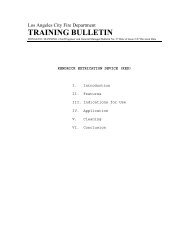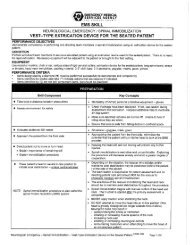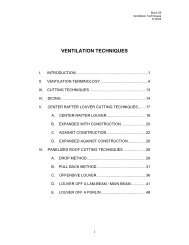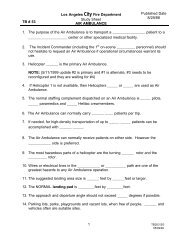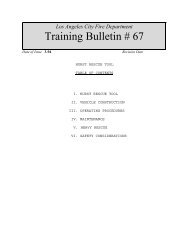SMOKE REMOVAL I. INTRODUCTION ... - LAFD Training
SMOKE REMOVAL I. INTRODUCTION ... - LAFD Training
SMOKE REMOVAL I. INTRODUCTION ... - LAFD Training
Create successful ePaper yourself
Turn your PDF publications into a flip-book with our unique Google optimized e-Paper software.
<strong>SMOKE</strong> <strong>REMOVAL</strong><br />
i<br />
Book 29<br />
06/12/00<br />
I. <strong>INTRODUCTION</strong> .........................................................................1<br />
A. Ventilation Methods<br />
1. Natural Ventilation<br />
2. Pressure Ventilation<br />
B. Pressurized Ventilation<br />
1. Negative Pressure Ventilation<br />
2. Positive Pressure Ventilation<br />
C. Implementation of Positive Pressure Ventilation<br />
1. Entrance Opening<br />
2. Air Flow Between Openings<br />
3. Exhaust Opening<br />
4. Weather<br />
5. <strong>Training</strong> and Communication<br />
II. BLOWER PLACEMENT .............................................................7<br />
A. Single Blower<br />
B. Multiple Blowers<br />
1. In Series<br />
2. Parallel<br />
3. Areas Without Exhaust Openings
ii<br />
Book 29<br />
06/12/00<br />
III. STRUCTURAL CONSIDERATIONS ......................................11<br />
A. Below Ground<br />
B. Dwellings<br />
1. Single Story<br />
2. Multiple Story<br />
C. Multi-Habitational Buildings<br />
D. Commercial Buildings<br />
IV. OPERATIONAL GUIDELINES................................................17<br />
A. General<br />
B. Multiple Floors<br />
C. Water Powered Blowers<br />
D. Overhaul<br />
1. Carbon Monoxide Guidelines<br />
2. Overhaul Guidelines
<strong>INTRODUCTION</strong><br />
1<br />
Book 29<br />
Smoke Removal<br />
06/12/00<br />
The primary goal of effective ventilation operations is the reduction or removal of<br />
smoke, heat, and fire gases (contaminants) from a structure or enclosed area in a<br />
timely manner. Proper blower placement will assist in achieving this goal. This<br />
process will result in the following:<br />
• Assist in search and rescue, extinguishment, overhaul, and other suppression<br />
operations.<br />
• Reduce or eliminate the numerous products of combustion.<br />
• Reduce the interior temperature within a structure.<br />
• Improve visibility for occupants and fire suppression personnel.<br />
• Increased safety for occupants and fire suppression personnel.<br />
• Reduce fire loss.<br />
VENTILATION METHODS<br />
Plans for ventilation operations should begin by identifying the direction (horizontal<br />
or vertical) contaminants must travel to exit the contaminated area. Once the<br />
direction of travel is established, the method for moving the contaminated contents<br />
must be determined.<br />
There are two basic methods that are utilized to pressurize a contaminated area to<br />
enhance or direct the travel of contaminants to the exterior. These are natural and<br />
mechanical positive pressure ventilation.<br />
Natural Ventilation<br />
As a fire burns within a confined building, the fire floor is filled with products of<br />
combustion that rise and fill all available spaces within a building. A simple method<br />
to ventilate products of combustion consists of utilizing natural convection currents.<br />
This is easily accomplished by opening doors, windows, skylights, and other similar<br />
openings. Although this method may perform satisfactorily, it is dependent on the<br />
following factors:<br />
• Proximity of the ventilation opening to the contaminants to be removed.<br />
• Ability of the contaminants to travel unobstructed to a ventilation opening.<br />
• Number and size of ventilation openings.
• Direction of wind.<br />
• Humidity.<br />
• Temperature differential between the interior and exterior of a building.<br />
Pressure Ventilation<br />
2<br />
Book 29<br />
Smoke Removal<br />
06/12/00<br />
Natural ventilation is a viable method that is effective within certain limitations.<br />
However, by utilizing portable blowers, the natural ventilation process can be<br />
dramatically assisted or replaced by FORCING the movement of contaminants to:<br />
• Exit through pre-selected and/or controlled openings.<br />
• Allow the use of ventilation openings that are remote from the contaminants to<br />
be removed.<br />
• Overcome interior - exterior temperature differentials.<br />
• Move contaminants to the exterior of a building through areas or openings not<br />
normally utilized by natural ventilation.<br />
• Reduce the time necessary to ventilate a building when compared to natural<br />
ventilation operations.<br />
PRESSURIZED VENTILATION<br />
The current methods that are utilized to provide pressurized ventilation with portable<br />
blowers are negative and positive pressure ventilation. To examine these two<br />
methods, the building in Figure 1 will be ventilated. In this example, the building is<br />
filled with various products of combustion from a fire. The warmer gases have risen<br />
to the top of the building, and the cooler gases have settled at the bottom of the<br />
building. The door and windows are closed.<br />
DOOR WINDOW<br />
Negative Pressure Ventilation<br />
FIGURE 1
3<br />
Book 29<br />
Smoke Removal<br />
06/12/00<br />
To ventilate the building, the door is opened and a blower is placed INSIDE the<br />
building to exhaust the contaminants as in Figure 2. This method will draw the<br />
contaminants within the building through the blower and exhaust the contaminants to<br />
the exterior of the building by creating a negative pressure within the building. By<br />
opening the window, the exhausting contaminants will be replaced with fresh<br />
incoming air. Although this method performs satisfactorily, negative pressure<br />
ventilation has the following disadvantages:<br />
EXHAUST<br />
NEGATIVE<br />
PRESSURE<br />
FIGURE 2<br />
INCOMING<br />
AIR<br />
• Personnel must be exposed to hazardous contaminants to position a blower.<br />
• Contaminants are drawn through the blower, creating additional equipment<br />
cleanup and maintenance.<br />
• Blowers placed in doorways or hallways can block entry or exit to the building.<br />
• To be effectively positioned, blowers suspended in doorways or windows must<br />
utilize straps, ladders, or other accessories.<br />
• Interior blowers are not efficient in removing contaminants at the top of a room or<br />
building. Air will follow the path of least resistance, which is normally a straight<br />
line from the fresh air inlet to the blower. This limits the flow of air at the top of<br />
the area to be ventilated.<br />
Positive Pressure Ventilation
4<br />
Book 29<br />
Smoke Removal<br />
06/12/00<br />
To ventilate the building, the door is opened and a blower is positioned OUTSIDE<br />
the building as in Figure 3. This method will force clean, fresh, pressurized air<br />
inside the building and create a positive pressure (similar to blowing up a balloon)<br />
inside the building.<br />
POSITIVE<br />
PRESSURE<br />
FIGURE 3<br />
EXHAUST<br />
The positive pressure will be equal at the top, bottom, and corners of the building<br />
common to the pressurized air. When the window is opened, the contaminants from<br />
ALL parts of the pressurized building will exhaust to the exterior (similar to piercing<br />
a hole in a blown-up balloon). Compared to negative pressure ventilation, positive<br />
pressure ventilation has the following advantages:<br />
• Personnel are not exposed to hazardous interior contaminants while positioning<br />
exterior blowers.<br />
• Contaminants are not drawn through blowers, resulting in minimal cleanup and<br />
maintenance.<br />
• Doorways, windows, and halls do not need to be blocked by blowers.<br />
• Exterior blowers are not dependent on additional equipment or accessories for<br />
setup and operation. Additionally, less time, and in some instances, less<br />
personnel are required to put exterior blowers into operation as no other<br />
equipment or accessories are necessary.<br />
• Reduced noise level.<br />
• Exterior blowers are efficient in removing contaminants at the top, bottom, and<br />
corners of a room or building.<br />
• Compared to negative pressure ventilation, positive pressure ventilation is<br />
approximately twice as effective at removing contaminants from a building.<br />
IMPLEMENTATION OF POSITIVE PRESSURE VENTILATION
5<br />
Book 29<br />
Smoke Removal<br />
06/12/00<br />
The effective implementation of positive pressure, as in Figure 4, is dependent on<br />
the entrance opening, airflow between openings, exhaust opening, weather, training<br />
and communication.<br />
Entrance Opening<br />
Blowers must be positioned so the cone of air issued from a blower will completely<br />
cover the entrance opening to eliminate contaminants being forced back through the<br />
"unsealed portions" of the entrance opening and being reintroduced into the<br />
pressurized building. This is accomplished by varying the distance from the blower<br />
to the entrance opening.<br />
Air Flow Between Openings<br />
It is imperative that the path of pressurized air between an entrance and exhaust<br />
opening be controlled to achieve maximum ventilation. If pressurized air is directed<br />
from an entrance opening to an appropriate exhaust opening (without being diverted<br />
to other openings), contaminants will be removed with the pressurized air in a<br />
minimal amount of time. Simultaneously opening multiple windows and/or doors will<br />
not facilitate a successful positive pressure ventilation operation.<br />
Exhaust Opening
6<br />
Book 29<br />
Smoke Removal<br />
06/12/00<br />
Exhaust openings can be selected to provide horizontal or vertical ventilation of<br />
contaminants. The location of the exhaust opening is dependent on the location of<br />
heat and smoke, and the prioritization of suppression operations (overhaul, search<br />
and rescue, extinguishment, etc.). The size of the exhaust opening is dependent on<br />
the size of the entrance opening, and capacity and number of blowers being utilized.<br />
Positive pressure is most efficient when the exhaust opening (heat hole, window,<br />
door, etc.) is between three-fourths (3/4) to one and three-fourths (1 3/4) the size of<br />
the entrance opening. This variance is due to the number and cubic feet per minute<br />
rating (CFM) of blowers that are utilized. An 18 inch blower utilizes a smaller<br />
exhaust opening than a 24 inch blower. A single blower utilizes a smaller exhaust<br />
opening than multiple blowers in parallel or series configurations. Optimum<br />
efficiency is easily obtained by a combination of training and practical experience.<br />
If a gasoline powered blower is being utilized and an exhaust odor is noticeable<br />
inside the building or area to be ventilated, this is an indicator that the exhaust<br />
opening is not large enough. The exhaust odor should disappear by increasing the<br />
size of the exhaust opening (opening another window, door, etc.)<br />
Weather<br />
Temperature, humidity, and rain do not have any appreciable effect on positive<br />
pressure ventilation. Although cold-damp weather conditions may limit the ability of<br />
smoke to rise, these atmospheric conditions will not limit the ability of blowers to<br />
move contaminants horizontally, and in most cases, vertically.<br />
Wind can have an adverse effect on positive pressure ventilation, but its effect is<br />
dependent on direction and velocity. As in any ventilation operation, maximum<br />
efficiency can be obtained by utilizing the prevailing wind direction to an advantage<br />
(windward to leeward). It is most advantageous to pressurize the structure on the<br />
windward side and exhaust contaminants on the leeward side of the building. If it is<br />
not possible to utilize the prevailing wind as an advantage, positive pressure has<br />
proven effective AGAINST winds (leeward to windward) of up to 25 mph; efficiency<br />
will be reduced accordingly.<br />
<strong>Training</strong> and Communication<br />
The key to effective positive pressure ventilation is dependent on controlling the<br />
entrance opening, the path of the interior air flow, and the exhaust opening. These
7<br />
Book 29<br />
Smoke Removal<br />
06/12/00<br />
factors can only be maintained in their proper relationship if all personnel engaged<br />
in the ventilation operation have been properly trained and are aware of the goal of<br />
the intended operation. If personnel are not assigned specific tasks, they should not<br />
arbitrarily move and/or reposition blowers or alter exhaust openings.<br />
SINGLE BLOWER<br />
BLOWER PLACEMENT<br />
A single blower should be positioned so the cone of pressurized air JUST covers<br />
the entrance opening as in Figure 5. If the blower is too close to the opening, the<br />
opening will not be completely covered by pressurized air. If the blower is too far<br />
from the opening, pressurized air will strike the area around the opening, reducing<br />
the amount of pressurized air being forced inside the building. Optimum placement<br />
is dependent on the size of the entrance opening and the CFM of the blower. These<br />
two factors will regulate the distance between the blower and the entrance opening.<br />
FIGURE 5<br />
Small blowers (18") need to be moved back from entrance openings while larger<br />
blowers (24") can be placed closer to entrance openings to properly cover the<br />
opening with pressurized air. This is due to the size of the "pressurized cone" of air<br />
issued from a blower. This operation can be enhanced by "tilting" a blower. Tilting<br />
blowers at angles more than the manufacturer designed will result in a lack of<br />
lubrication to the crank shaft.
MULTIPLE BLOWERS<br />
8<br />
Book 29<br />
Smoke Removal<br />
06/12/00<br />
Multiple blowers can dramatically increase CFM when used in series or provide<br />
proper coverage of the opening when used in parallel. Multiple blowers can also<br />
reduce the time necessary to complete a ventilation operation.<br />
In Series<br />
For standard entrance openings maximum effectiveness is achieved by placing two<br />
blowers in series (in-line) with each other.<br />
In Figure 6, Blower A is positioned about two-feet from the entrance opening. This<br />
ensures that all of the pressurized air from the blower enters the building, yet allows<br />
sufficient room for ingress/egress of personnel. Blower B is positioned behind<br />
Blower A. The proper location for Blower B is determined by the distance<br />
necessary to cover the entrance opening with pressurized air.<br />
Blower B is utilized to cover the entrance opening with pressurized air, force<br />
pressurized air into the building, and increase the capacity of blower A by<br />
approximately 10%.<br />
POSITIVE<br />
PRESSURE<br />
A B FIGURE 6<br />
EXHAUST<br />
If two blowers of unequal CFM are utilized in the series position, place the large<br />
blower about two feet back from the entrance opening and utilize the smaller blower<br />
behind the larger blower to cover the entrance opening with pressurized air. This<br />
configuration will utilize the larger blower to provide most of the pressurized air for<br />
the ventilation operation while the small blower covers the entrance opening, and<br />
increases the efficiency of the larger blower.<br />
If the area in front of an entrance opening is limited to three feet or four feet (i.e.,<br />
raised porch), place the smaller blower in the entrance opening and the larger<br />
blower three to four feet back from the door. Use the larger cone of pressurized air<br />
to seal the entrance opening.
Parallel<br />
9<br />
Book 29<br />
Smoke Removal<br />
06/12/00<br />
For standard entrance openings, multiple blowers in a parallel (side-by-side)<br />
configuration are less effective than multiple blowers in a series configuration.<br />
However, for large entrance openings, multiple blowers in a parallel configuration<br />
(Figure 7), should be utilized due to their combined ability to cover the larger<br />
opening with pressurized air. The size of the opening will dictate the number of<br />
blowers that will be necessary to cover the opening with combined cones of<br />
pressurized air. Remember that some openings (i.e., loading-dock doors) can be<br />
reduced in size by partially closing the door which will reduce the size of the<br />
entrance opening that must be covered by pressurized air. Depending on the<br />
number of blowers that are available, large areas may be effectively ventilated by<br />
utilizing a combination of parallel (proper coverage of the opening) and series<br />
(increased CFM) blowers.<br />
Areas Without Exhaust Openings<br />
FIGURE 7<br />
Areas or locations that do not have an exhaust opening (storage rooms, offices,<br />
enclosed work areas, etc.) can be effectively ventilated by using multiple blowers.<br />
In figure 8, Blower A is positioned to provide a flow of air past the opening. This<br />
blower can be located outside the building to provide pressurized air to the interior<br />
of the building and past the area to be ventilated. Blower B is positioned in the<br />
bottom portion of the opening and will provide pressurized air that will create a<br />
positive pressure within the area to be ventilated and force the contaminants out of
10<br />
Book 29<br />
Smoke Removal<br />
06/12/00<br />
the upper portion of the entrance opening. The air flowing past the entrance<br />
opening will force the exhausting contaminants to follow its direction to the exterior<br />
of the building.<br />
A<br />
B<br />
FIGURE 8<br />
If the flow of air past the opening is not sufficient, the exhausting contaminants from<br />
the area to be ventilated can circulate back into the blower in the bottom portion of<br />
the opening. To alleviate this condition, use an additional blower (Blower C in<br />
Figure 9) to provide a sufficient flow of air past the exhausting contaminants and<br />
Blower B.<br />
A C<br />
FIGURE 9<br />
STRUCTURAL CONSIDERATIONS<br />
Below ground areas should be treated as any other smoke removal problem with<br />
the following added considerations:<br />
B
1. Use of creative methods may be required to channel the smoke i.e., use of<br />
salvage covers, additional blowers, etc.<br />
11<br />
Book 29<br />
Smoke Removal<br />
06/12/00<br />
2. The smoke that is exhausted from the below ground area in many cases will<br />
accumulate in the ground level floor (or higher) and will require evacuation from<br />
its new location.<br />
3. Management of this smoke in the above ground area in vital.<br />
4. Removal of the smoke at or above ground level will be accomplished using<br />
standard positive pressure ventilation techniques.<br />
DWELLINGS<br />
Single Story<br />
Effective ventilation requires SYSTEMATIC VENTILATION of contaminated areas<br />
within a building. This process will provide the maximum amount of pressurized air<br />
from a blower to ventilate each contaminated area within a building. This results in<br />
maximum efficiency and minimal time for ventilation. During positive pressure<br />
operations, do not "open the structure up" as is common practice. This will reduce<br />
the flow of air through each room and increase the time for ventilation.<br />
Additionally, remember that removing screens on windows prior to using these<br />
openings for ventilation purposes will increase the efficiency of these openings by at<br />
least 50%.<br />
Assume that a kitchen fire, in Figure 10, has charged the dwelling with smoke. All<br />
doors and windows are closed, a blower has been positioned to cover the front<br />
door with pressurized air, positive pressure would by utilized as follows:
4 TH<br />
5 TH<br />
6 TH<br />
3 RD<br />
BATHROOM 1<br />
2 ND<br />
BEDROOM 1<br />
12<br />
1 ST<br />
EXHAUST<br />
BEDROOM 2 KITCHEN<br />
DINING<br />
ROOM<br />
BATH<br />
ROOM 2<br />
BEDROOM 3<br />
FIGURE 10<br />
LIVING ROOM<br />
Book 29<br />
Smoke Removal<br />
06/12/00<br />
• To clear the kitchen, living room, and dining room, open the exterior door in the<br />
kitchen and both interior doors to the kitchen. When these rooms have cleared,<br />
close the exterior kitchen door.<br />
• To clear bedroom one, open the bedroom door and window. When cleared,<br />
close the window or door.<br />
• To clear bathroom one, open the bathroom window. When cleared, close the<br />
window or door.<br />
• To clear bedroom two, open the bedroom door and window. When cleared,<br />
close the window or door.<br />
• To clear bathroom two, open the bathroom door and window. When cleared,<br />
close the window or door.<br />
• To clear bedroom three, open the bedroom door and window. When cleared,<br />
close the window or door.<br />
Closing a door or window of an area will yield the same results.<br />
Additionally, an area that has open walls or ceilings (from a fire), or other large<br />
openings, can be isolated from a ventilation operation by closing an appropriate<br />
door if applicable. Remember that it is possible to ventilate several rooms at one
time with multiple blowers.<br />
Multiple Story<br />
13<br />
Book 29<br />
Smoke Removal<br />
06/12/00<br />
Assume a first floor fire, in Figure 11, has charged the multiple story dwelling with<br />
smoke.<br />
SECOND<br />
EXHAUST<br />
FIRST<br />
EXHAUST<br />
FIGURE 11<br />
To ventilate the first floor, ensure that all exterior windows on the upper floor are<br />
closed, or a stairshaft door to the upper floor is closed (whichever is appropriate).<br />
Position a blower at an appropriate entrance opening, and systematically ventilate<br />
the contaminated areas on the first floor of the structure. This will provide maximum<br />
pressurized air for ventilation on the first floor, and no flow of air on the second floor<br />
due to the lack of an exhaust opening.<br />
To ventilate the second floor, leave the blower in the same position and ensure that<br />
all exterior windows and doors are closed on the first floor. If a stairshaft door has<br />
been closed, open the door and systematically ventilate the contaminated areas on<br />
the second floor.<br />
Due to the lack of an exhaust opening on the first floor, pressurized air from the<br />
blower will pressurize the first and second floor, but will only create a flow of air on<br />
the second floor due to its exhaust openings.<br />
MULTI-HABITATIONAL BUILDINGS
14<br />
Book 29<br />
Smoke Removal<br />
06/12/00<br />
These types of buildings generally have multiple floors, and enclosed central<br />
hallways that provide access to numerous rooms within the building. The hallways<br />
may be of considerable length (depending on the size of the building) and may<br />
incorporate Ponet Doors at various intervals within the hallways. If Ponet Doors are<br />
present, they may be opened to allow pressurized air to travel to a specific location,<br />
or they may be closed to "compartmentalize" specific sections of a building. This<br />
may be useful to keep contaminants from spreading to uncontaminated areas, or to<br />
divert pressurized air to a specific area.<br />
Multi-habitational occupancies can be effectively ventilated with positive pressure<br />
by:<br />
• First, pressurizing appropriate stairways and hallways.<br />
• Second, ventilating contaminated rooms or other areas that are common to a<br />
pressurized hallway dependent on the location of the most heat and smoke, and<br />
the prioritization of suppression operations (overhaul, search and rescue,<br />
extinguishment, etc.).<br />
Assume a third floor, rear apartment fire, in Figure 12, has charged the third floor<br />
with smoke. The building has an enclosed stairshaft that is common to each floor,<br />
and Ponet Doors separating each floor from the stairshaft.<br />
HORIZONTAL<br />
EXHAUST<br />
VERTICAL<br />
EXHAUST<br />
FIGURE 12<br />
Position blowers outside the building to cover the entrance of the stairshaft to be<br />
pressurized. Open the third floor hallway door to the stairshaft that is being<br />
pressurized with air from the blowers, and ensure that the ponet doors to the first<br />
and second floors are closed. By opening the door to the involved apartment, the<br />
stairshaft, the third floor hallway, and the involved apartment will be pressurized.<br />
Horizontal and/or vertical exhaust openings can be used in the involved apartment.
15<br />
Book 29<br />
Smoke Removal<br />
06/12/00<br />
The hallway and apartment will be cleared of all contaminants. This is most<br />
effectively accomplished by opening a patio sliding glass door, large window, or<br />
using a room with the greatest number of windows as the initial exhaust opening.<br />
When the hallway and that portion of the apartment utilized as an exhaust opening is<br />
cleared, systematically ventilate the other portions of the apartment.<br />
Depending on the floor plan of a building and the location of the fire, opposing<br />
blowers as illustrated in Figure 13 can be effectively utilized to remove the<br />
contaminants in a hallway and an apartment. Blowers of unequal ratings or equal<br />
ratings can be effectively utilized for this ventilation operation.<br />
FIGURE 13<br />
A multi-habitational occupancy that may need creative techniques are two story<br />
center hallway apartments. These buildings do not utilize ponet doors which result<br />
in vertical openings between the first and second floor hallways. Depending on the<br />
location of smoke in the hallways, normal positive pressure operations may cause<br />
the smoke to circulate between the first and second floor hallways before exiting the<br />
building.<br />
To alleviate this condition, use two blowers as illustrated in Figure 14. This<br />
placement of multiple blowers will enhance the pressurization and EQUAL flow of air
on each floor. The removal of smoke can be accomplished as follows:<br />
2<br />
3<br />
1<br />
A B<br />
FIGURE 14<br />
NOTE: For this operation Blower B can be placed just inside the door (as<br />
illustrated) or outside the door (as per standard practice).<br />
• Involved apartment (Door 1) used as an exhaust opening.<br />
• Second floor window (Window 2) used as an exhaust opening.<br />
• First floor hallway door (Door 3) used as an exhaust opening.<br />
COMMERCIAL BUILDINGS<br />
16<br />
Book 29<br />
Smoke Removal<br />
06/12/00<br />
Commercial buildings vary in their size, height, and use. However, the following<br />
factors should be applied when considering ventilation operations for these types of<br />
buildings.<br />
Depending on the size of the structure, some commercial occupancies such as<br />
warehouses and manufacturing occupancies offer large open areas that are<br />
normally difficult to ventilate. These occupancies require a combination of blowers<br />
that are capable of providing adequate CFM for the area to be ventilated and an<br />
understanding of positive pressure principles.<br />
When possible, large areas of a building should be divided into smaller areas by<br />
closing partition doors, rolling or sliding fire doors, etc., and then systematically<br />
ventilating each contaminated area. Large structures that are comprised of smaller<br />
areas such as stock rooms, work stations, offices, etc., should be ventilated by<br />
using systematic ventilation techniques in a pre-planned, coordinated operation.<br />
When large ventilators, removed skylights, or ventilation openings in a roof (heat<br />
holes and strips) will negatively effect positive pressure operations, use these<br />
openings as vertical exhaust openings. Openings such as doors and windows that
17<br />
Book 29<br />
Smoke Removal<br />
06/12/00<br />
are below these exhaust openings must be closed to ensure the flow of pressurized<br />
air is maximized and directed to vertical exhaust openings.<br />
OPERATIONAL GUIDELINES<br />
Depending on the type of building, determine the effectiveness of removing<br />
contaminants horizontally or vertically. Include heat holes and strips when evaluating<br />
exhaust openings. Additionally, determine the path that pressurized air must travel<br />
to remove contaminants within the building. Consider where the most heat and<br />
smoke is in relationship to the location of the exhaust opening.<br />
GENERAL<br />
It may be necessary to pressurize vertical stairshafts to horizontally ventilate upper<br />
floors of a multi-story building. If possible, reduce large areas into smaller areas<br />
and ventilate systematically.<br />
Large structures or large areas within structures require increased CFM to remove<br />
large quantities of contaminants. Consider the use of larger blowers for these<br />
applications. Multiple blowers in series will also provide additional CFM and<br />
enhance the removal of contaminants. Multiple blowers in parallel will provide<br />
proper coverage for large entrance openings. Various types of large doors can be<br />
partially closed to facilitate the pressurization of an entrance opening.<br />
MULTIPLE FLOORS<br />
Buildings with multiple floors can be ventilated by systematically ventilating each<br />
floor, as in Figure 15. Start where there is the most heat and smoke. This will most
18<br />
Book 29<br />
Smoke Removal<br />
06/12/00<br />
likely be the fire floor due to Ponet Doors, it could also be the top floor where heat<br />
and smoke will have mushroomed because the Ponet Doors did not close.<br />
Stairshafts can be used to channel pressurized air to each floor as necessary.<br />
Position blowers(s) on the exterior of the building and pressurize the opening to the<br />
stairshaft that is common to the contaminated floors. Systematically ventilate each<br />
floor by opening a door to the pressurized stairshaft and an appropriate window as<br />
an exhaust opening. For information concerning cross ventilation by utilizing<br />
opposing stairshafts in sealed buildings, reference Book 100, High Rise Incident<br />
Command System, Chapter 6.<br />
WATER POWERED BLOWERS<br />
FIGURE 15<br />
Water powered blowers will produce considerably more CFM than the same size<br />
5<br />
4<br />
3<br />
2<br />
1
19<br />
Book 29<br />
Smoke Removal<br />
06/12/00<br />
gasoline blowers and should be considered for metro rail tunnels, high rise<br />
buildings, large underground parking structures, and very large commercial<br />
buildings. They also pressurize air without carbon monoxide as a by-product and<br />
should be considered in rest homes, hospitals, and other types of structures where<br />
respiratory concerns should be considered. Water powered blowers are<br />
intrinsically safe and can be utilized at hazardous materials incidents.<br />
OVERHAUL<br />
Overhaul operations are conducted for the purpose of ensuring a fire is completely<br />
out, determining the probable fire cause, and leaving the owner or insurance<br />
adjusters some means of determining the loss. However, overhaul operations are<br />
often conducted in conditions that may be tenable yet hazardous to personnel.<br />
Unless a fire has been TOTALLY extinguished and the contaminated structure<br />
COMPLETELY ventilated, overhaul operations may be conducted within varying<br />
concentrations of smoke, heat, carbon monoxide, and other toxic gases.<br />
Remember that any carbon monoxide that has been collected at the top of a room<br />
or building (as a result of a fire) may have cooled and settled within the area of<br />
overhaul personnel. Additionally, common building materials retain and radiate heat<br />
that has been generated by a fire. This can result in elevated temperatures during<br />
overhaul operations.<br />
Typically, most blowers are utilized for ventilation operations after the initial knock<br />
down of a fire and prior to overhaul operations. This will allow heat, smoke, and<br />
carbon monoxide to ACCUMULATE during overhaul operations. Positive pressure<br />
can be utilized during overhaul operations to provide a flow of fresh-cool air through<br />
the overhaul area, as in Figure 16.<br />
HEAT<br />
<strong>SMOKE</strong><br />
CO<br />
OVERHAUL<br />
MATERIAL<br />
FIGURE 16<br />
This will result in the following conditions being improved:<br />
• Radiated heat within the overhaul area will be reduced. Additionally, humidity is
educed.<br />
20<br />
Book 29<br />
Smoke Removal<br />
06/12/00<br />
• Smoke within the overhaul area can be substantially reduced depending on the<br />
degree of extinguishment within the overhaul area.<br />
• Similar to heat and smoke, concentrations of carbon monoxide and other toxic<br />
gases can be significantly reduced.<br />
Carbon Monoxide Guidelines<br />
Depending on the type of fire, concentrations of carbon monoxide within the range<br />
of 500 parts-per-million (ppm) to 1200 ppm are easily obtainable during overhaul<br />
operations.<br />
NOTE: For comparative purposes, the following guidelines are regarded as<br />
acceptable carbon monoxide concentration standards:<br />
• to 500 ppm of carbon monoxide can be inhaled for one hour without appreciable<br />
effects.<br />
• to 700 ppm of carbon monoxide inhaled for one hour will cause some<br />
appreciable effects.<br />
• to 1200 ppm of carbon monoxide inhaled for one hour is dangerous.<br />
• Concentrations of 4000 ppm of carbon monoxide and over are fatal in less than<br />
one hour.<br />
Measurements during actual overhaul operations have indicated that positive<br />
pressure can easily reduce carbon monoxide concentrations of 1000 ppm to<br />
approximately 130 ppm to 220 ppm.<br />
Overhaul Guidelines<br />
The effectiveness of using positive pressure during overhaul operations is<br />
determined by the overhaul area (size and overhaul materials) and the blowers that
21<br />
Book 29<br />
Smoke Removal<br />
06/12/00<br />
are utilized for positive pressure. A single 18" blower is adequate for an average<br />
(2000 square feet) single family dwelling. Remember that as the CFM is increased,<br />
so is the effectiveness. A MODERATE movement of air is sufficient to cause<br />
smoke, heat, and carbon monoxide within the overhaul area to move in the direction<br />
of an exhaust opening. Positive pressure does not have a tendency to accelerate or<br />
spread fire that may still be in the overhaul area. However, caution should be<br />
exercised when using positive pressure with smoldering type fires (i.e., mattress,<br />
overstuff, etc.) If any fire does begin to accelerate or spread, it can easily be<br />
controlled by:<br />
• Extinguishing the fire.<br />
• Turning the blower 90 degrees away from opening.<br />
• Reducing the RPM of the blower.<br />
• Increasing the distance between the overhaul area and the blower.<br />
• Shutting the blower off.<br />
NOTE: Positive pressure should never be utilized in place of a Self-Contained<br />
Breathing Apparatus (SCBA). SCBA should ALWAYS be used when<br />
personnel encounter hazardous atmospheres.<br />
TMFH:rr



